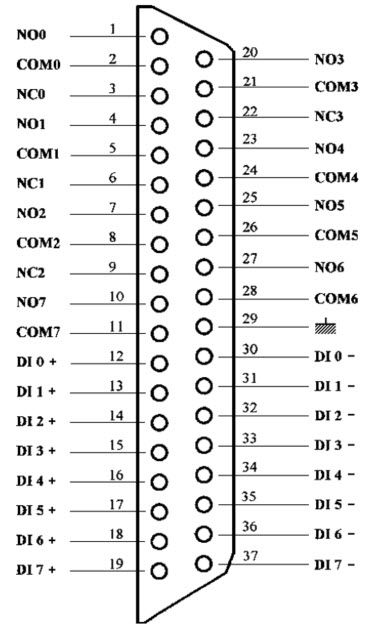The wiring is a function of the pin assignment of the card connector, so it will be necessary to refer to the documentation of this one (see internet links below).
For troubleshooting, here is the pin assignment of the DB37 female connector of commonly used 8-channel relay output cards (ISA or PCI), namely:
•Advantech / AdClone ACL / PCL-725
•ICP-DAS P8R8DIO
•Decision Computer Int'l 8i / 8o PCI
http://www.decision.com.tw/ (http://www.smatlab.com/)
•ADLink PCI-7250
Note that the model ICP-DAS P16R16DIO (16 inputs, 16 outputs) is composed of 2 connectors DB37 modeled on the same pinouts as below:

Broaching:
NO: relay contact normally open.
NC: relay contact normally closed.
COM: common relay contact.
DIn +: Entrance, positive pole.
DIn-: Input, negative pole (or ground, 0 V).
WARNING: Not all cards work in the same way at the output level (electromechanical relay, reed relay (ILS), open collector output, TTL, ...) as for the inputs (LEDs of the unpolarized optocouplers, inverted logic , presence of a bias voltage, etc ...).
Precautions regarding Outputs:
For card models with relay outputs, the contacts are intended for resistive loads only and support a maximum of 1A at 24V =. Under no circumstances should a voltage> 48 volts be present (so no 220 V ~ !!!). See the documentation of the card if in doubt.
Input Precautions:
The inputs are galvanically isolated via an optocoupler; There are 2 modes of operation:
- Inputs requiring a bias voltage: An input is at logic level 1 when a DC voltage of 9 to 12 volts is applied to the inputs: the '+' to be connected to DIn +, and the '-' to DIn + (typically the mass, or 0 V).
To put a logic input low, just leave DIn+ and DIn- in the air or put DIn + to ground. (We can also connect DIn+ and DIn- between them but suddenly this wiring becomes incompatible with other input systems).
Note: Some card models can be configured to accept AC voltage (12 Volts ~ MAX).
Inputs 'self powered' or 'dry contact', need not need bias voltage: an input is at logic high when DIn+ and DIn-- are connected together, and at the logic low with DIn+ and DIn- in the air.
Decision Comp Int'l cards (8-channel card only) are configurable in 'bias voltage' or 'self powered / dry contact' mode. Note that in "polarization" mode it is essential to specify the INVERT_IN clause in the registry (see + up).
When sending a bias voltage to the inputs, you must protect them: To avoid smoking the card in case of overvoltage, it is imperative to put in series for each input a limiting resistor (470 ohms for 12 volts ). Do not hack by putting a common resistance to multiple entries !!!